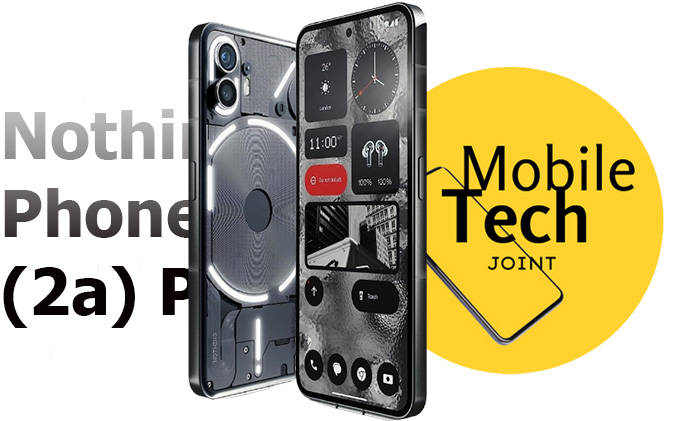I am a fan of this company and, I’ve been eagerly following their journey in the smartphone market. When I got my hands on the Nothing Phone 2a Plus, I was curious to see how this “Plus” variant would differentiate itself from its predecessor. After spending several weeks with the device, I’m ready to share my in-depth thoughts on this intriguing mid-range offering.

Key Takeaways:
| Pros | Cons |
| Unique transparent design | Minor upgrades from Phone (2a) |
| Improved 50MP front camera | No significant design changes |
| Slightly faster charging (50W) | Limited Glyph interface utility |
| Good battery life | Camera performance needs optimization |
| Clean, bloatware-free software | No infrared sensor |
Design and Build: Familiar Territory with a Metallic Twist
When I first unboxed the Nothing Phone 2a Plus, I was struck by its familiar design. The device retains the transparent back panel and Glyph interface that have become Nothing’s signature aesthetic. However, the new metallic Gray and Black color options add a touch of sophistication to the overall look.
The phone’s “anthropomorphic” design, as Nothing calls it, remains unchanged:
- Dual rear cameras positioned like eyes
- NFC coil resembling a brain
- 26 addressable LED zones for the Glyph interface
While I appreciate the consistency in design language, I couldn’t help but feel a bit disappointed by the lack of significant changes. The plastic build feels light in hand, which some users might prefer, but it does make the device prone to smudges and scratches.
One notable omission that I found puzzling was the lack of an infrared sensor, a feature commonly found in many mid-range competitors. This could have been a worthwhile addition to set the Plus variant apart.
Display: Vivid and Smooth
The Nothing Phone 2a Plus sports a 6.7-inch Full HD+ flexible OLED display with a 120Hz refresh rate. During my testing, I found the screen to be a joy to use:
- Vibrant colors and deep blacks
- Excellent viewing angles
- Two display modes: Standard and Alive (for punchier colors)
- HDR10+ support for enhanced media consumption
The 120Hz refresh rate made scrolling and animations feel buttery smooth, enhancing the overall user experience. I particularly appreciated the 2160Hz PWM Dimming, which helped reduce eye strain during extended use.
Performance: A Slight Boost
At the heart of the Nothing Phone 2a Plus lies the MediaTek Dimensity 7350 Pro chipset, a custom-made processor developed in collaboration with MediaTek.
This chip is essentially an overclocked version of the Dimensity 7200 Pro found in the original Phone 2a. Here’s how it stacks up:
- Up to 10% faster CPU performance
- Up to 40% better GPU performance
- AnTuTu scores reaching over 800,000
In my day-to-day use, the phone felt snappy and responsive. Multitasking was smooth, and app launches were quick. However, when I pushed the device with more demanding tasks, some limitations became apparent:
- Gaming performance: While casual games ran flawlessly, graphically intensive titles like Genshin Impact showed occasional lag and frame drops.
- Thermal management: During extended gaming sessions, the phone did warm up noticeably, though not to uncomfortable levels.
For the average user, the Nothing Phone 2a Plus offers more than enough power for daily tasks, social media, and light gaming. However, hardcore mobile gamers might want to look elsewhere for more consistent performance.
Camera: A Mixed Bag
The camera setup on the Nothing Phone 2a Plus includes:
- Dual 50MP rear cameras (main + ultra-wide)
- 50MP front-facing camera (upgraded from 32MP on the Phone 2a)
In my testing, I found the camera performance to be decent but not outstanding. Here’s a breakdown of my experience:
Rear Cameras:
- Daylight performance: Good detail and natural colors
- Ultra-wide shots: Slightly less impressive, with some loss of detail
- Low-light photos: Decent noise reduction, but room for improvement
Front Camera:
- Selfies: Sharp in good lighting, but struggles in low-light conditions
- Video: 4K@30fps support is a nice addition
One interesting feature is the ability to choose between “Natural” and “Vivid” color modes. I found the Natural mode to produce more true-to-life results, while Vivid added a bit more pop to the images without going overboard.
While the cameras are capable, I felt that some software optimization could significantly improve the overall output, especially in challenging lighting conditions.
Software: Clean and Unique
Running on Nothing OS 2.6 based on Android 14, the Phone 2a Plus offers a clean and minimalist software experience. Some highlights include:
- No bloatware
- Customizable Glyph interface
- AI-generated wallpapers
- Experimental features like easy Apple AirPods pairing
The promise of 3 years of OS updates and 4 years of security patches is reassuring for long-term use. However, I did notice that the Glyph interface, while visually striking, still lacks truly compelling use cases beyond basic notifications and charging indicators.
Battery Life and Charging: A Step Up
The Nothing Phone (2a) Plus retains the 5,000mAh battery of its predecessor but bumps up the charging speed to 50W (up from 45W). In my testing, I found the battery life to be impressive:
- Easily lasted a full day of moderate to heavy use
- Often stretched into a second day with lighter usage
- 22 hours and 38 minutes in a battery loop test
The faster 50W charging is a welcome improvement, though I was disappointed to find that no charger is included in the box. Using a third-party 68W charger, I achieved the following charging times:
- 0-30% in 15 minutes
- 0-63% in 30 minutes
- Full charge in about 55 minutes
Conclusion: A Modest Upgrade in a Competitive Market
After spending considerable time with the Nothing Phone (2a) Plus, I’m left with mixed feelings. On one hand, the device offers a unique design, clean software, and solid battery life. The slight performance boost and improved front camera are welcome additions.
However, in the fiercely competitive mid-range smartphone market, these incremental upgrades might not be enough to justify the price increase over the original Phone (2a). At a starting price of Rs 27,999, the Phone (2a) Plus faces stiff competition from devices like the Honor 200, Realme GT 6T, Motorola Edge 50 Pro, and OnePlus Nord 4.
For those who prioritize Nothing’s distinctive aesthetic and clean software experience, the Phone 2a Plus is worth considering. However, if you’re looking for the absolute best performance or camera quality in this price range, you might want to explore other options.
Ultimately, the Nothing Phone 2a Plus is a capable mid-range device that stands out more for its design than its technical prowess. It’s a solid choice for Nothing fans and those who appreciate a unique smartphone experience, but it may not be the best value proposition for everyone in this highly competitive segment.
Also Check:
- iPhone 16 Pro Max Release Date: Here’s When You Can Expect the Next Big…
- iPhone 16 Pro Max Colors: What to Expect From Apple’s Next Big Release
- iPhone 16 Pro Max: Why Apple’s Next Flagship Could Redefine Smartphones in 2024?
- Rumored iPhone 16 Pro Max: A Stunning Design with Cutting-Edge Features and a Titanium…
- Here’s Why the New Google Pixel Buds A Series Could Be Your Next Favorite…
